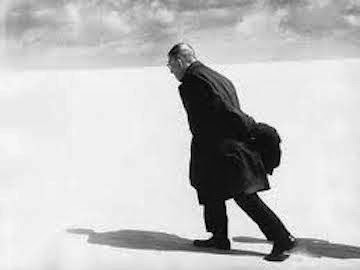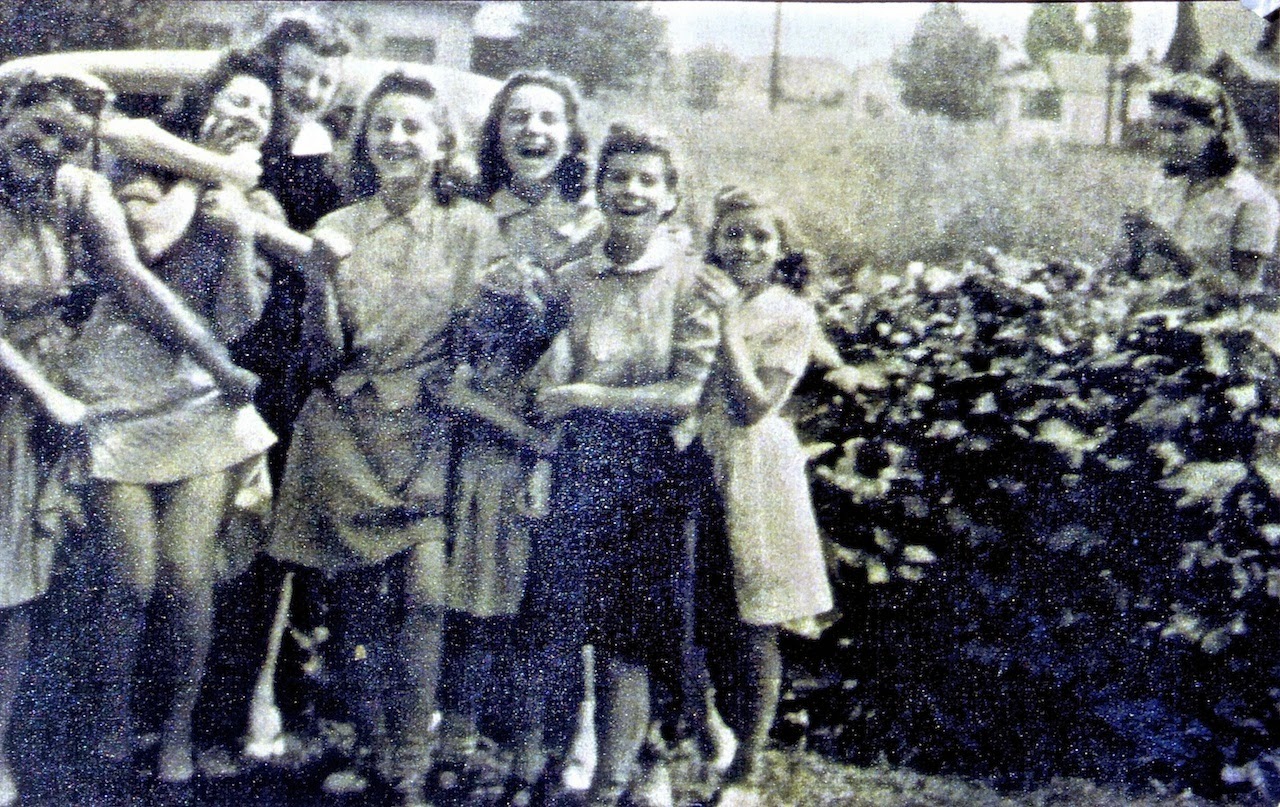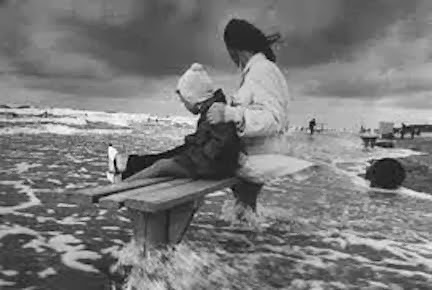On a visit to my brother’s home in North Carolina, I came across this photo of my mom and a couple of her sisters; I don’t know who took the photo or when it was taken (perhaps early 1940’s); so much of my mom’s Polish immigrant story has been buried deep in the memories of her now-deceased relatives. But I’m guessing this is sometime after the Second World War, and my mom (second from left) is being teased by her friends (one is pulling up her skirt) and the girls are being silly, laughing and having a great time together. There is a beautiful spontaneity and joi de vivre in their expressions. I imagine a very tight bond was formed among the neighborhood girls at a time when brothers and fathers were coming back home to their families from the hellfire of war.
I was so focused on my mom that I missed the young girl in the top right-hand corner of the photo; my first thought went to Mark Twain’s quote: Be good and you will be lonesome.
But then I wondered beyond that simplification. The girl appears sad and introspective; maybe she was too frightened to join in on the exuberant fun the other girls exhibited. The more I looked, the more I wondered about her; how did her life develop over the years; did she live an ordinary, pedestrian life marked by the usual joys and tragedies of simply being human?
Black and white photos like this one are at once provocative and vividly memorable. I love seeing my mother as a young girl, before the concerns for her family and children took center stage. There is a story here, told in the absence of color, that is deeply affecting.
A story that parallels my own in a way: growing up in a Michigan suburb with tight neighborhood friends; spending most of our time outdoors exploring streets beyond our own, climbing trees, riding bikes, playing games. Growing into self-awareness, and expanding that self-awareness beyond those in our circle of friends, to others on the sidelines who may have been too frightened or too shy to take part.
I became fascinated with the work of Antanas Sutkus, a renowned Lithuanian black and white darkroom photographer born in 1939 (he still eschews digital). His series People of Lithuania is a continuing body of work started in 1976 to document the changing life and people of Lithuania.
“I know the ordinary man; he is close to me,” Sutkus is quoted as saying.
The excitement of seeing in the darkroom, for the first time, a white sheet of paper turn into an image was unforgettable and drove Sutkus to claim photography as his life’s work. For him, taking pictures of conventional informality was “warming”; after working a short time as a photojournalist, he intuited a style of his own, leaving much open to the viewer’s interpretation, though strongly anchored in historical time.
Sukus reports he discovered himself through the art of photography. He accumulated a large personal library, following the expressions of Andre Kertesz, Diane Arbus, Robert Frank, and others. He collected many photographic books found in antique book stores in Moscow as well as in Germany and Poland.
Perhaps this photo of the girl and a goat’s head best exemplifies his work in the rural areas of Lithuania, where living day to day meant the raising and killing of animals for sustenance.
We are looking inside this young girl’s life as she looks out the window, revealing a cold reality and perhaps dire set of circumstances, but again, Sukus leaves it up to the viewer to develop her own interpretation. What is compelling are the two sets of eyes looking straight at the viewer, unifying the idea that living a life gives way to taking a life. Lastly, take a look at Sutkus’ kinetic photograph of philosopher and novelist, Jean-Paul Sartre, pushing into a headwind, perhaps, or deep in thought on the subject of existentialism and the human condition; just one of many subjects that captivated the mind of this most fascinating man.
 “It is shocking to see how easily snow falls outside the window…”
“It is shocking to see how easily snow falls outside the window…”
…this uttered by Sutkus in reference to how long and hard he works, day and night, with an irritated brain that sometimes cannot find rest.
In his later years, he writes how he would like to distance himself from unnecessary work and action and just rest in a simple state of being, without so much “doing.” If there is any secret to Sutkus’ long-standing success as a photographer, it would be in his easy, unadorned quote:
“Love. You just have to love people.”




That's what retirement is doing for me… spending time with less doing, more thinking and relaxing. Still can't sleep, ha.. but that's because of physical pains.. even in this restlessness, I find peace when I do finally get to sleep. With no pressure to get things done, I can dream freely, and all night.. Dreams that are creative and oblique, wild and crazy and sedate as making my bed in a dream, ha. Still, I do get out and see people, more on my terms than theirs.. thanks for sharing this.. Mike
sleep is such a big issue and changes in quality and duration as we age; which is, in a way, too bad. Now that we have the time to create, the energy to do so is harder to come by…Sutkus was well aware of this; he touches on the matter of sleep in his writings Lucky you, though. I rarely remember my dreams, but keep a notebook on the side table, just in case.
Oh yes, Monica…this way of capturing unadulterated life, no filters or films between us, just the artist's eye hauling up from ordinary days wondrous sights. Time, I say take it now. Don't wait for retirement. Just carve it out. I heard someone my age, with teens, complain about not having time to write and in the same sentence talking about watching TV for hours. It is a matter of choice. Maybe this is a strong opinion, but I believe it. xo S
Whenever I look at old photographs, I see stories in them. Probably the thing that saddens me most is the reality that, with my mother/father/aunts/uncles, etc. gone, there's no one who can tell me about the people I don't recognize — which gives them even less meaning to the next generation (i.e., my daughter/nieces/nephews). And the photos by Antanas Sutkus are extraordinary. Thanks for the introduction to his work.
I love the "ancient" black and white photo's, even of unidentified people, especially of unidentified people. In our local hospital there is a long wall of old black & whites of our town and its people in the town's infancy. So many many many people of today pause and gaze and study those unidentified folks. It is uplifting to see, both the pictures and the mesmerized lookers. There are pictures of Indians coming into town, and there is a picture of people wearing nose masks as they try to avoid some dread illness going around. Horses, wagons, cars, dirt streets. I love that wall. AND I love all your works of art. Thanks
I'm with you on that, Suzi. Because I've seen myself watch TV for hours, and then wonder, why am I doing this, by default? There is a choice and we have the power to make it. I just don't want to die without exploring the song in my heart.
Sutkus' work is so bare boned and beautiful; always begging a story. Thanks for taking a look, Deborah.
There is a black and white photo montage in the heart of Anchorage depicting the big 'quake of 1964 that I find fascinating. The street you're standing on was once crumpled, buildings destroyed. So many stories; and I really think black & white is the best medium to tell them.
It's amazing what a close inspection of a photograph might reveal. Sometimes someone else will notice something in a picture I've taken that I hadn't noticed when I took it.
I'm wondering what the woman in the top right hand corner of the photo is holding in her hands… She almost looks like she's texting, but that can't be it!
The photo of the Lithuanian girl and goat's head is striking. Monica, have you ever seen the movie, "Everlasting Moments"? I have a feeling you would enjoy it.
http://www.youtube.com/watch?v=G2xCNxapDik&feature=related
Ah, Barbara. I can't thank you enough for the recommendation…films about the lives of artists and photographers are so interesting, especially at the turn of the centruy. The societal restraints put upon women artists is stinging; yet they triumph anyways, because they HAVE to.
It's interesting, Monica, but though I'm not a convinced fan of b&w photography, I don't miss colour in any of these photos…
Whoever took the photo of the girls did a great job. I wonder whether he included the girl in the right top corner on purpose or did it happen by chance? We'll never know but the story told by the contrast between the group and the lonely and sad girl remains and is open to imagination.
The photos by Antanas Sutkus look impressive, thank you for introducing his work and personality. I'm going to search for more information about him, to see more of his photographs.
I wonder who took the photo of my mom; someone in the family, a neighbor? I'll never know. So much is open to interpretation. Thanks for your insights, Petra.
In the 50's and 60s I was that girl at the side. To all appearances, I was part of the group – but I felt isolated and alone. If I had known of Twain's quotation at that point, I would have believed it, because I was a very good girl, and I was very lonesome.
But time has passed, and many, many experiences, both good and bad. Today, when I hear that line, "Be good, and you will be lonesome," I hear Jimmy Buffett singing it, and the lines that come after, too.
Be good and you will be lonesome
Be lonesome and you will be free
Live a lie and you will live to regret it
That's what living is to me
That's what living is to me
I've lived a lie or two in my life, and I lived to regret it. Now? I'm more alone in many ways than ever before, but I'm infinitely more free. No more living lies, no more regret. Thanks for bringing this back to mind.
Ha. I had no idea Jimmy Buffet created a song with that quote. Thanks for the U-Tube; first time I'd heard it. This whole notion of being alone…I went to a poetry reading tonight, and my husband decided to stay home; he said "you'll be going all by your lonesome"…and I replied, gosh, I sure don't feel lonesome. Being social sometimes feels more lonesome than being alone.